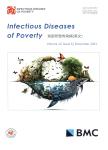Distribution of and associated factors for dengue burden in the state of Odisha,India during 2010-2016
Distribution of and associated factors for dengue burden in the state of Odisha, India during 2010-2016作者机构:Indian Institute of Public Heaith-BhubaneswarPublic Health Foundation of IndiaBhubaneswarOdishaIndia Regional Medical Research CenterIndian Council of Medical ResearchBhubaneswarOdishaIndia School of MedicineUniversity of NottinghamNottinghamUK UQ Spatial Epidemiology LaboratorySchool of Veterinary ScienceThe University of QueenslandGattonQLD 4343Australia UQ Child Health Research CentreChildren’s Health and Environment ProgramThe University of QueenslandSouth BrisbaneQLD 4101Australia
出 版 物:《Infectious Diseases of Poverty》 (贫困所致传染病(英文))
年 卷 期:2019年第8卷第3期
页 面:72-81页
核心收录:
基 金:This study was financially supported by the PHRI-Research Grant awarded by Public Health Foundation of India with the financial support from Department of Science and Technology Government of India(No.IN-DL220960833674480)
主 题:Disability adjusted life year Dengue Burden Distribution India
摘 要:This study is aimed to estimate the epidemiological burden of dengue in Odisha,India using the disability adjusted life year(DALY)methods and to explore the associated factors in the year *** the period of 2010-2016,27772 cases(68.4%male)were reported in the *** age(years)of male and female was 31.63 and 33.82,*** district wise disability adjusted life years(DALY)per 100000 people was higher in the year 2016(0.45)and mean DALY lost per person was highest in the year 2015(34.90 years).Adjusted regression model indicates,every unit increase in humidity and population density increases DALY by 1.05 and 1.02 units ***,unit change in sex ratio(females per 1000 males)and forest coverage increases the DALY by 0.98 *** results indicate geographical variation of DALY in Odisha,which is associated with population density,humidity and forest *** identified between standard incidence and DALY maps suggests,latter can be used to present disease burden more *** prevalence among young males suggests the need of strengthening the targeted prevention and control measures.



